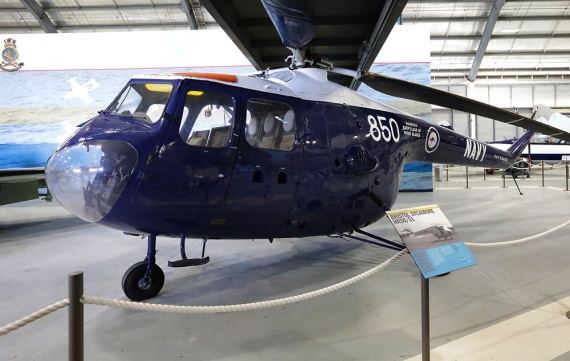Bristol Sycamore HR50/51
| Type |
Rescue and Training Helicopter |
|---|---|
| Manufacturer |
Bristol |
| Number Ordered |
13 |
| First Delivered |
1953 |
| Last Delivered |
1961 |
| Length |
46 feet 2 inches |
| Height |
12 feet 2 inches |
| Weights | 4050 pounds |
| Dimensions | Wing span: 48 feet 6.75 inches (rotor) |
| Speed | 127 mph (max sea level), 91 mph (cruising) |
| Range |
238 miles |
| Crew |
2 |
| Engines | One 520 hp Alvis Leonides Mk72 7 cylinder radial air-cooled engine |
| Performance |
|
| Ships embarked in |
The Royal Australian Navy (RAN) Fleet Air Arm was formed in 1948 and the first aircraft carrier HMAS Sydney (III) commissioned in February 1949. A second carrier HMAS Vengeance was loaned to the RAN in March 1953 and served until March 1956; she was replaced by HMAS Melbourne (II) when she arrived in Australia. The air sea rescue aircraft operated by the RAN in 1949 was a seaplane, the Sea Otter, which was less than suitable for use with the new aircraft carriers and a decision was made to obtain helicopters for the air-sea rescue task.
Following a lengthy review of suitable types the RAN placed its first order for three Bristol Sycamores (HR.50 Model) from the United Kingdom in late 1951. These helicopters arrived in Australia, on board the aircraft carrier Vengeance, on 11 March 1953. They were then flown off to the Naval Air Station (HMAS Albatross) at Nowra and taken on charge by 723 Squadron; formed on 7 April 1952. Except for a short period during October 1956-February 1957 when the Sycamores were part of 724 Squadron they were operated exclusively by 723 Squadron.
A total of 13 Sycamore helicopters (ten being the HR.51 Model) were acquired by the RAN, with two embarked in Melbourne during her delivery voyage to Australia, while the remainder were delivered to Australia as sea freight. Sycamores were to be deployed regularly on board the carriers Sydney, Vengeance and Melbourne, for air-sea rescue duties and general personnel and stores carrying tasks. During their service in the carriers the Sycamore helicopters operated throughout Australian waters, Southeast Asia and the western Pacific region. Routine maintenance was conducted at Nowra, or on board the carriers, while major overhaul and upgrades was contracted to Bristol Aviation Services at Bankstown Airport, Sydney.
In the early 1960s planning began to find a replacement for the Sycamore and in 1964 the new Bell Iroquois helicopters, from the United States, were acquired. Of the 13 RAN Sycamores six crashed during service; this included two lost from HMAS Melbourne in 1957 and one from HMS Hermes in 1961. The three others were destroyed in crashes at Maitland (1956), Grafton (1958) and Nowra in 1962. The remaining RAN Sycamores were retired from service in June 1965 and sold to museums.






